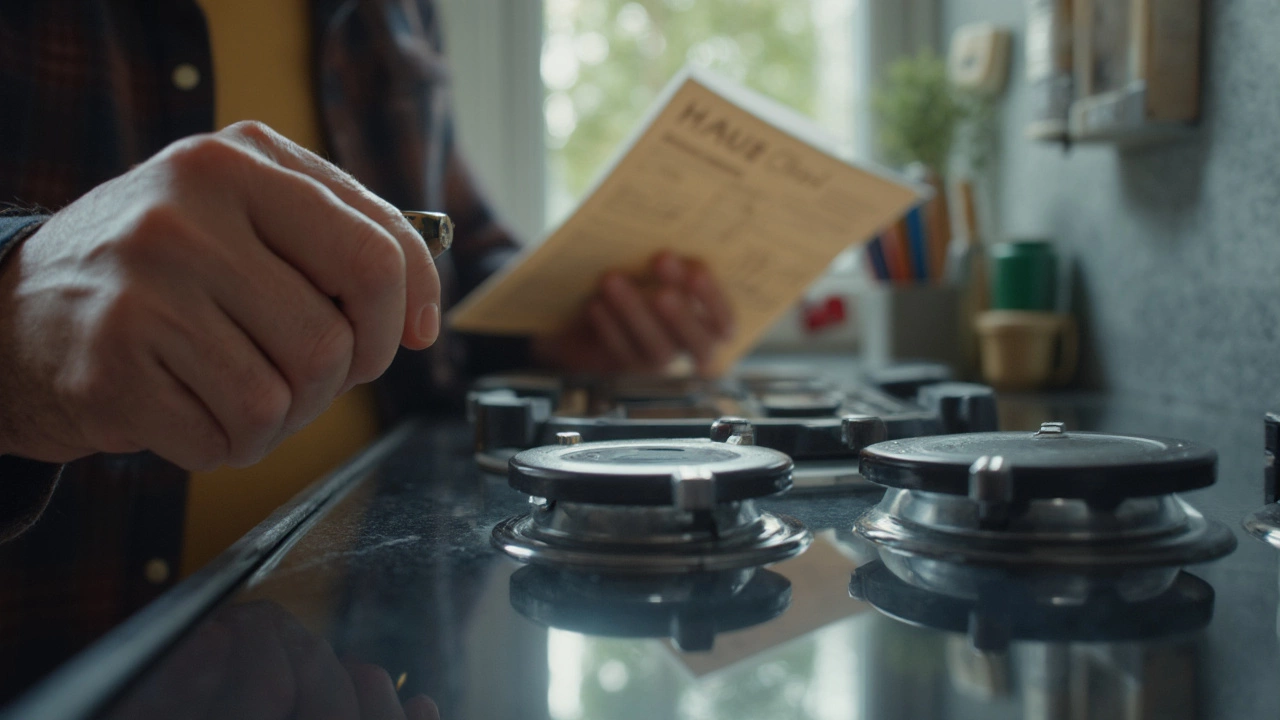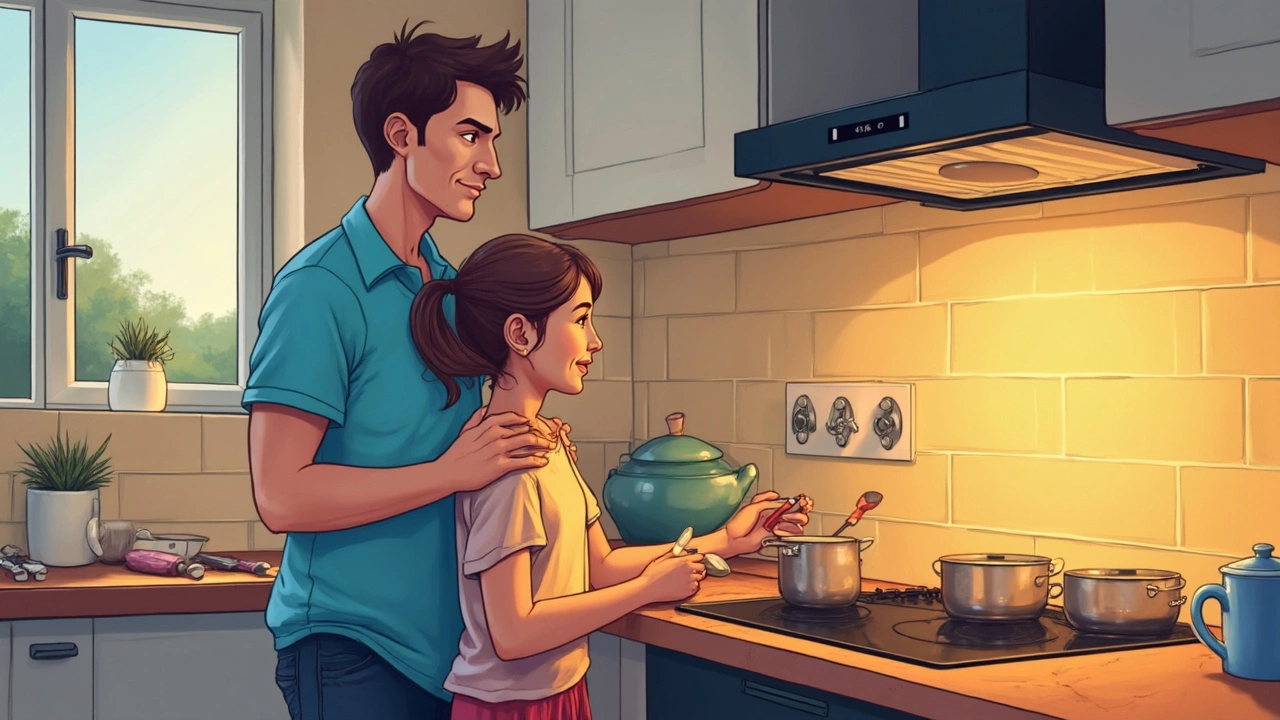When your electric stove acts up, it’s usually one of two things. Either a burner won’t heat, or the entire thing stays stubbornly cold. Both problems can bring dinner prep to a dead stop, and trust me, nothing ruins taco night like a cold skillet.
If you’ve got a stove that’s giving you the silent treatment, start by checking the basics. Is it plugged in all the way? Did a circuit breaker trip? These can sound obvious, but I’ve lost count of how often folks (myself included) miss the simple stuff while scrambling to fix a phantom problem. Not every issue means the stove is toast—sometimes, it’s just a loose plug or a tired old fuse.
- Spotting the Usual Suspects: Burners Not Heating
- When the Entire Stove Says No: Power Failures
- Home Fixes and Quick Checks That Actually Work
- When to Call in a Pro (and What to Expect)
- Tips to Avoid Trouble Next Time
Spotting the Usual Suspects: Burners Not Heating
It’s a classic move: you turn the dial and nothing happens except a lot of pointless waiting. When an electric stove burner won’t heat, there are a few likely reasons. The good news? Most are pretty easy to check at home before you bring in a repair tech.
The main troublemakers behind a non-heating burner are:
- Burned-out heating element: This is the part that actually glows red and gets hot. Over time, these wear out—especially if you use the same burner all the time. If it’s got visible cracks, blisters, or black burn marks, it’s probably shot.
- Loose or faulty connection: Sometimes, the element gets knocked out of its slot or the contact gets dirty. A wobbly or poorly-seated element won’t transfer power.
- Bad burner socket: The part the element plugs into can go bad, especially on older stoves. If you see charring or corrosion where the burner sits, that could be the problem.
- Broken switch: The dial or control knob can fail, meaning even a new element won’t heat up. This is a less common cause, but it happens, especially if you turn the same knob every night.
If you want to spot the problem yourself, just swap the burner that isn’t working with one from a different spot on the stove. If the replacement works in the same socket, your original burner is dead. But if the borrowed burner doesn’t heat up either, you might be looking at a bad socket or a wiring issue instead.
| Possible Cause | What You'll Notice | DIY Test? |
|---|---|---|
| Burned-out element | Burner looks damaged, doesn’t glow | Try swapping with another burner |
| Loose connection | Burner wiggles or moves easily | Reseat burner, check if it works |
| Bad socket | Burner & replacement burner won’t heat | Visual check for burn marks/corrosion |
| Faulty switch | None of the burners heat in one spot | Professional check recommended |
You’d be surprised how often fixing a burner just means pushing it in more firmly or giving the contacts a quick clean with a dry cloth (make sure the stove’s off first, obviously). But if you spot damage or if nothing you try works, that’s a sign you might need a new element or socket. Replacement parts are usually easy to find online or at hardware stores, and if you’re comfortable, swapping them out doesn’t require fancy tools—just a screwdriver and a little patience. However, don’t mess with the wiring unless you really know what you’re doing; safety comes first!
When the Entire Stove Says No: Power Failures
If you go to cook and the entire stove acts dead—no lights, no clicks, nothing—it’s usually a power issue. The most common cause for an electric stove not turning on is a tripped circuit breaker. Most kitchen stoves use a dedicated 220-240V line with a double breaker. If more than one appliance runs on that same circuit (think microwave, toaster oven, or kettle), it can trip easily.
Before you panic, check these basics:
- Peek at your electrical panel. Is the breaker in the "off" position? Flip it all the way off and then on again. Don’t just nudge it; it has to click.
- Is the power cord firmly plugged in? Over time, heavy ovens can wiggle just enough to loosen a plug, especially if you move the stove for cleaning.
- Look for visible wear on the power cord. Fraying or melted insulation is a definite red flag—don’t use the stove if you see this. Get a pro involved.
Here’s a quick look at the most common reasons for total electric stove failure and how often they happen:
| Problem | Likelihood | DIY Fix? |
|---|---|---|
| Tripped circuit breaker | High (about 50%) | Yes, reset the breaker |
| Loose or unplugged power cord | Moderate (20%) | Yes, secure the plug |
| Blown fuse (older homes) | Low (10%) | Maybe, if comfortable replacing fuses |
| Internal wiring issue | Medium (15%) | No, call a pro |
| Broken control board | Low (5%) | No, pro needed |
If you reset the breaker and nothing happens, listen close—some stoves have a fuse inside that can blow if there’s a power surge. You’ll usually need to drag the stove away from the wall to check this. If you’re not comfortable poking around with wiring, it’s a job for a certified appliance tech.
It’s worth mentioning that modern kitchens with ground-fault circuit interrupter (GFCI) outlets may trip if moisture or oil sneaks into the receptacle. Hit the "reset" button on the outlet and see if the powers back up. Remember, whenever you’re working with anything electrical, safety comes first. When in doubt, don’t risk it—get someone trained to check it out.
The big takeaway? If your electric stove problems point to power—the fix might be easier (and cheaper) than you think, as long as you know what to look for.

Home Fixes and Quick Checks That Actually Work
If your electric stove stops working, don’t jump to calling for repairs. Most of the time, the fix is easier (and cheaper) than you think. Here are a few things you can do right in your kitchen before you spend any money or grab a toolbox.
- Electric stove problems often start with loose connections—make sure the power cord is plugged in tight. If it's wobbly, unplug it and plug it back in firmly.
- Check the circuit breaker or fuse box. A stove can trip a breaker if there’s a power surge or overload. If one is flipped, reset it and see if your stove wakes up.
- If a burner isn’t heating, switch it with another burner of the same size (just unplug and swap them). If the new burner works in the same spot, your original burner is likely dead, not the stove itself.
- Wipe down the burner contacts. Grease and grime can block a good connection. A quick clean with a dry cloth (make sure everything's cool and unplugged first!) can solve surprise glitches.
Here’s a quick look at what usually goes wrong, how often it happens, and if you can fix it yourself:
| Problem | How Common? | DIY Fixable? |
|---|---|---|
| Burner Not Heating | About 40% of reported stove issues | Yes, if it’s just the burner or dirty contacts |
| Stove Won't Turn On | Roughly 35% of calls to repair techs | Many can be fixed by checking power & breakers |
If after all these checks your stove is still as cold and quiet as a library, then it could be something inside—like a busted infinite switch or a fried wire—which is usually better left to the experts. But honestly, nine out of ten times it's a minor thing you can spot with a careful look.
When to Call in a Pro (and What to Expect)
If you’ve flipped switches, checked fuses, reseated burners, and your stove still isn’t heating, it’s probably time to call in a professional. Here’s the deal: electric ovens and stoves have high-voltage parts that aren’t safe for everyone to tinker with. Some problems, like a busted control board or fried wiring, honestly need specialized tools and know-how.
You should get a pro involved if:
- The stove keeps tripping the breaker, even after you reset it.
- None of the burners work—sounds like a wiring or internal connection issue.
- You smell burning, notice scorch marks, or see sparks.
- The temperature never matches what you set, or the oven display flashes error codes.
- You tried swapping out burner coils, but nothing changed.
With oven repair, don’t guess—electric stoves draw around 240 volts, enough zap to ruin your day. Licensed techs have the right test gear and can diagnose stuff like broken thermostats, faulty control switches, or hidden electrical shorts in less time than it takes to watch an episode of your favorite show.
Here’s what usually happens during a electric stove problems service call:
- The tech will ask about what’s been happening—be as detailed as you can, even if it sounds small.
- They’ll inspect the power supply, connections, burners, and control panel. Most bring replacement parts for typical fixes.
- After testing, they’ll explain what broke and your repair options. If it’s a common part—like a burner switch or thermal fuse—you might see everything wrapped up the same day.
Want a ballpark of what folks pay for repairs? Here’s a handy table with typical US costs, as of early 2025:
| Repair Type | Average Cost (USD) |
|---|---|
| Burner Replacement | $75–$150 |
| Oven Control Board | $200–$400 |
| Wiring Fix/Short | $100–$250 |
| Temperature Sensor | $100–$180 |
If your stove is over ten years old, weigh repair against replacement. Sometimes, it makes more sense to put that money toward a new model. Either way, a good tech will walk you through your choices without any hard selling.
Got pets like Buddy and Whiskers at home? Keep them clear of the area while the tech works—just makes life easier for everyone.

Tips to Avoid Trouble Next Time
Tired of dealing with surprise electric stove problems? A bit of prevention can really pay off. Here’s how to keep your stove running smoothly, so you can actually enjoy home-cooked meals instead of staring at a broken appliance.
- Clean spills right away: Boil-overs and splatters can sneak under burners and mess with connections. Once a week, give the top a wipe with a damp rag. Don’t let bits of food get baked onto the burners or into the control knobs.
- Check your burners: If you see hot spots, warping, or discoloration, swap the burner to another spot. Does the problem follow the burner? If yes, it’s time for a replacement. If not, the socket might need attention.
- Be gentle with dials and settings: Cranking knobs too hard or slamming pots down shortens your stove’s lifespan. Buddy, my golden retriever, once knocked a pan off the stove chasing Whiskers. Accidents happen, but try to be careful—your stove will last longer.
- Check your power supply: Once a month, make sure the cord isn’t frayed or the plug isn’t loose. Faulty connections are a top reason for power issues in electric stoves.
- Don’t overload the outlet: Plugging in too many appliances on the same circuit can trip breakers. Stick to the stove and maybe a light or clock—leave the toaster elsewhere.
If you’re the numbers type, take a look at how regular care stacks up:
| Maintenance Task | Frequency | Reduction in Repairs (%) |
|---|---|---|
| Wipe up spills | After Use | Up to 60% |
| Check burners and cords | Monthly | About 40% |
| Don’t overload circuit | Always | Up to 30% |
A typical electric stove lasts 13-15 years with normal use, but folks who follow these steps see fewer breakdowns and spend less on repairs. If you stay on top of things, that stove will be ready whenever hunger strikes. And that’s electric stove problems handled before they happen.
